Intermodal container. Container types
An intermodal container is a standardized reusable steel box used for the safe, efficient and secure storage and movement of materials and products. It implies that the container can be moved from one modeof transport to another without unloading and reloading the contents of the container. These operations allow carrying out the multimodal transportations by various types of transport with the minimum expenses of time and work, realizing a principle «from a door to a door».
Lengths of containers vary from 8-foot (2,438 m) to 56-foot (17,07 m) and heights from 8-foot (2,438 m) to 9 feet 6 inches (2,9 m).
Aggregate container capacity is often expressed in twenty-foot equivalent units (TEU/teu) which is a unit of capacity equal to one standard twenty-foot (6,10*2,44 m) (length*width) container. Two TEU are equivalent to one forty-foot equivalent unit (FEU).
Weights and dimensions of the some common types of containers:
Standard containers:
Standard containers (also known as general purpose containers) are used for all types general cargo
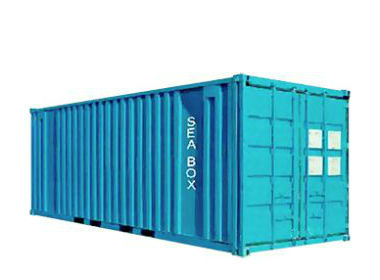
20 GP
| Length | Width | Height | |
|---|---|---|---|
| External dimensions | 20′ = 6096 mm | 7′ 9.25″ = 2370 mm | 8’ 6″ = 2591 mm |
| Internal dimensions | 19′ 5.75″ = 5935 mm | 7′ 8″ = 2335 mm | 7′ 9.75″ = 2383 mm |
| Door openings | 7′ 8″ = 2335 mm | 7′ 6.25″ = 2292 mm | |
Specifications
| Weights | |
|---|---|
| Max. gross weight | 52910 lbs = 24000 kg |
| Tare weight | 4585 lbs = 2080 kg |
| Max. payload | 48325 lbs = 21920 kg |
| Volume |

20 GP HQ
| Length | Width | Height | |
|---|---|---|---|
| External dimensions | 6058 mm | 2438 mm | 2689 mm |
| Internal dimensions | 5915 mm | 2350 mm | 2596 mm |
| Door openings | 2340 mm | 2458 mm | |
Specifications
| Weights | |
|---|---|
| Max. gross weight | 30500 kg |
| Tare weight | 2400 kg |
| Max. payload | 26500 kg |
| Volume |
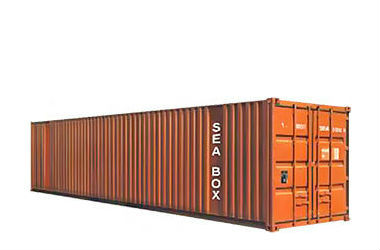
40 GP
| Length | Width | Height | |
|---|---|---|---|
| External dimensions | 40′ = 12192 mm | 8′ = 2438 mm | 8′ 6″ = 2591 mm |
| Internal dimensions | 39′ 5.25″= 12022 mm | 7′ 5.625″ = 2352 mm | 7′ 10.25″ = 2395 mm |
| Door openings | 7′ 8.25″ = 2343 mm | 7′ 5.75″ = 2280 mm |
|
Specifications
| Weights | |
|---|---|
| Max. gross weight | 67200 lbs = 30480 kg |
| Tare weight | 8600 lbs = 3900 kg |
| Max. payload | 58600 lbs = 26580 kg |
| Volume |

40′ HQ
| Length | Width | Height | |
|---|---|---|---|
| External dimensions | 40′ = 12192 mm | 8′ = 2438 mm | 9′ 6″ = 2895 mm |
| Internal dimensions | 39′ 3.25″= 12022 mm | 7′ 8.5″ = 2352 mm | 8′ 10.25″ = 2700 mm |
| Door openings | 7′ 5.75″ = 2340 mm | 8′ 5.75″ = 2585 mm | |
Specifications
| Weights | |
|---|---|
| Max. gross weight | 67200 lbs = 30480 kg |
| Tare weight | 9150 lbs = 4150 kg |
| Max. payload | 58050 lbs = 26330 kg |
| Volume |
Refrigerated containers
Refrigerated containers are used for goods which need to be transported at a constant temperature above or below freezing point.
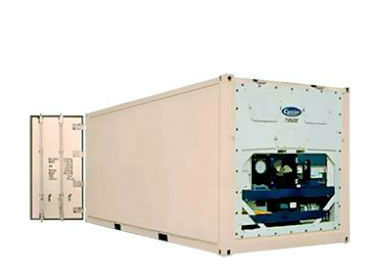
20 RF
| Length | Width | Height | |
|---|---|---|---|
| External dimensions | 20′ = 6096 mm | 7′ 9.25″ = 2370 mm | 8′ 6″ = 2591 mm |
| Internal dimensions | 5455 mm | 2260 mm | 2275 mm |
| Door openings | 2237 mm | 2260 mm |
|
Specifications
| Weights | |
|---|---|
| Max. gross weight | 67200 lbs = 30480 kg |
| Tare weight | 3050 kg |
| Max. payload | 23950 kg |
| Volume | 28.0 cub. m |
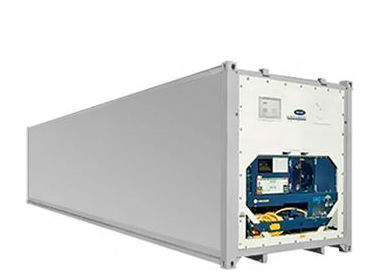
40 RF
| Length | Width | Height | |
|---|---|---|---|
| External dimensions | 40′ = 12192 mm | 8′ = 2438 mm | 8′ 6″ = 2591 mm |
| Internal dimensions | 11555 mm | 2286 mm | 2280 mm |
| Door openings | 2285 mm | 2245 mm |
|
Specifications
| Weights | |
|---|---|
| Max. gross weight | 67200 lbs = 30480 kg |
| Tare weight | 4370 kg |
| Max. payload | 26110 kg |
| Volume | 60.2 cub. m |

40HQ RF
| Length | Width | Height | |
|---|---|---|---|
| External dimensions | 40′ = 12192 mm | 8′ = 2438 mm | 9′ 6″ = 2895 mm |
| Internal dimensions | 11560 mm | 2286 mm | 2500 mm |
| Door openings | 2286 mm | 2478 mm |
|
Specifications
| Weights | |
|---|---|
| Max. gross weight | 67200 lbs = 30480 kg |
| Tare weight | 4200 kg |
| Max. payload | 26280 kg |
| Volume | 60.2 cub. m |
Open-top containers
Open-top containers are used for all types of general cargo. Their principal uses are as follows: packing and unpacking from above or through the doors by crane or crab; tall cargo.

20 OT
| Length | Width | Height | |
|---|---|---|---|
| External dimensions | 20′ = 6096 mm | 8′ = 2438 mm | 8′ 6″ = 2591 mm |
| Internal dimensions | 19′ 4.3″= 5902 mm | 7′ 4.1″ = 2240 mm | 7′ 8.5″ = 2352 mm |
| Door openings | 7′ 7.9″ = 2335 mm | 7′ 4.1″ = 2240 mm | |
Specifications
| Weights | |
|---|---|
| Max. gross weight | 52910 lbs = 24000 kg |
| Tare weight | 5380 lbs = 2440 kg |
| Max. payload | 47520 lbs = 21560 kg |
| Volume | 1133 cu. ft. = 32 cub. m |
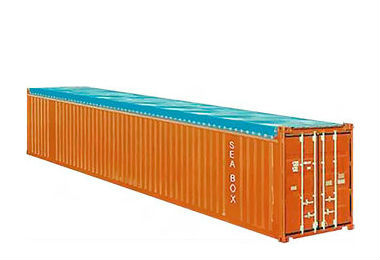
40 OT
| Length | Width | Height | |
|---|---|---|---|
| External dimensions | 40′ = 12192 mm | 8′ = 2438 mm | 8′ 6″ = 2591 mm |
| Internal dimensions | 39′ 5.2″= 12021 mm | 7′ 8.4″ = 2350 mm | 7′ 7.7″ = 2330 mm |
| Door openings | 7′ 8″ = 2338 mm | 7′ 3.8″ = 2234 mm | |
Specifications
| Weights | |
|---|---|
| Max. gross weight | 79370 lbs = 36000 kg |
| Tare weight | 9760 lbs = 4430 kg |
| Max. payload | 69600 lbs = 31570 kg |
| Volume |
Flatracks
Flatracks are mainly used to transport heavy-lifts and over height or over width cargo.
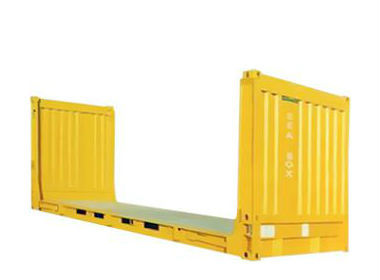
20 FR
| Length | Width | Height | |
|---|---|---|---|
| External dimensions | 20′ = 6096 mm | 8′ = 2438 mm | 8′ 6″ = 2591 mm |
| Internal dimensions | 18′ 9.4″ = 5727 mm | 7′ 4.1″ = 2240 mm | 7′ 1.3″ = 2170 mm 1′ 4.6″ = 420 mm (компактный) |
Specifications
| Weights | |
|---|---|
| Max. gross weight | 66140 lbs = 30480 kg |
| Tare weight | 6500 lbs = 2950 kg |
| Max. payload | 60690 lbs = 27530 kg |
| Volume |
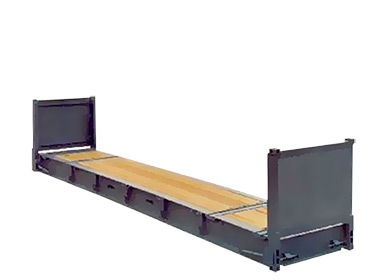
40 FR
| Length | Width | Height | |
|---|---|---|---|
| External dimensions | 12192 mm | 2438 mm | 2591 mm |
| Internal dimensions | 12032 mm | 2240 mm | 2034 mm |
Specifications
| Weights | |
|---|---|
| Max. gross weight | 88180 lbs = 45000 kg |
| Tare weight | 12190 lbs = 5530 kg |
| Max. payload | 87,020 lbs = 39470 kg |
| Volume |
Please also read other articles in this section:
How to Calculate CBM for a Sea Shipment and Air Shipment
CBM (or cubic meter) is the standard size that international sea shippers use to calculate how much to charge for cargo that is less than a container load (LCL). A CBM is defined as 1 meter high, wide and deep. You calculate it by multiplying the three dimensions of a box, crate or pallet in metric units. For example, a box that is 0.6 m high by 0.4 m wide by 1 m deep is 0.24 CBM. A CBM is approximately 35 cubic feet.
As for air cargo, air carrier usually charge the rate for kilo. And in order to avoid the situation, where light cargo can be charged less, volume weight can be applied. The formula for calculation is like this: Width (CM) X Height (CM) X Depth (CM) / 6000 = volume weight. So if the cargo is light, and 1 CBM for example is less than 166 kilo, it will be charged the rate for 166 kilos by air carrier anyway.



